Chapter
9
Turning
Your Yard into a Studio
Although photographing
birds in your back yard may not seem as exciting and exotic as going on
a serious shoot in some prime location far from home, yardbird photos
needn’t
be dull, uninteresting snapshots of birds sitting on a gaudy, plastic
feeder. With some effort and a bit of creativity, it’s often
possible to turn even the most sterile property into a productive
little bird photography studio. All it really takes is a window,
a means for supporting some attractive perches, some birdseed, and a
healthy population of local avifauna. In this chapter we’ll
consider some very basic methods for setting up an aesthetic shooting
environment at home.
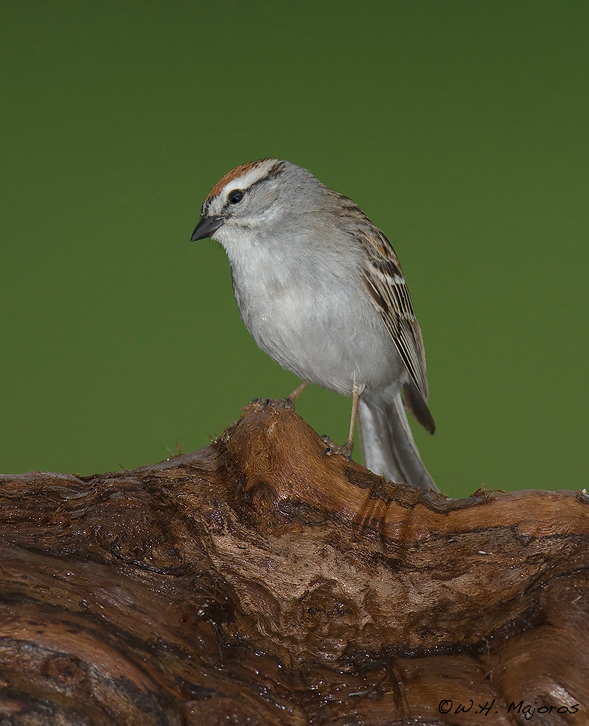
Fig. 9.1.1 : Shooting birds at your home gives you more control
over the backgrounds and the perching substrates, and makes
it easier to get the camera close to the bird. I photographed this
chipping sparrow from a comfortable chair at my front window.
The driftwood was purchased at PetSmart in the aquarium
department. I cropped out the bird feeder below it.
9.1
Natural and
Artificial Perches
It goes without saying that a bird
perched on a natural substrate, such as a branch or vine, tends to
spark the imagination of the viewer more than one photographed at a
plastic bird feeder. The feeder is of course useful for
attracting the birds, but if you’ve got some natural perches positioned
near the feeder, then you can wait until a bird perches on one of those
natural supports before taking your photo. Many birds will perch
first on a nearby branch before coming in to the feeder (possibly to
check for any signs of danger). Even if you don’t have any trees
in your yard, you can provide such intermediate perching sites quite
easily, as we’ll discuss below.
Fig. 9.1.2 :
Being able to swap out branches and replace them with new ones
allows you to avoid monotony in your yardbird photos. This photo
was taken in
the same exact location as the previous figure, but after swapping out
the block
of driftwood for a branch.
The first thing
to consider is the positioning of
the feeder itself. I have my feeder set up on a wooden 4×4 about 20 feet from my window
(see Fig. 9.1.3, below). I can open the window (there’s no
screen)
and shoot from the comfort of a chair inside my home, and the birds
rarely take notice of me—as long as I’m quiet and don’t make any sudden movements.
It’s important to choose a distance from your window that is both close
enough to allow you to capture detail in the bird, but far enough that
your camera can still focus (i.e., no closer than the minimum focus distance, or MFD—though you can use extension tubes
to reduce the effective MFD, as described in section 3.4).
Note that when shooting in cold weather it’s best to
turn off the heat
in your house, and position your lens as far out the window as
possible; otherwise, the heat differential between the air in your
house and the air just outside the window can result in blurry images,
and there may also be acclimation
effects involved when using a warm lens in cold air (or
vice-versa). In winter I simply turn off the heat in my house,
put on my coat, gloves, and ski pants, and pretend my house is just a
big photo blind. The first few images tend to be blurry, though
to what degree this is due to the optical effects of convection (as the warm air escapes
through the window) and how much is instead due to incomplete
acclimation of the lens isn’t entirely obvious to me.
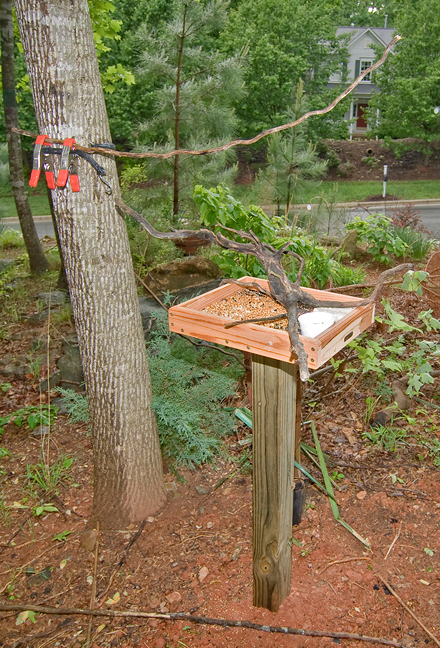
Fig. 9.1.3 : A platform feeder and perching substrates. Platform
feeders allow you to offer multiple types of food in one central
location, and free up the space above the food for the placement
of branches and other perching substrates.
The figure above shows the setup I’m currently using
at my home. This type of feeder is called a platform feeder, and is harder to
find (I ordered mine through Amazon.com). The feeder consists of
a bottomless wooden tray with a metal grating that allows water to pass
through but not seeds; the grating is removable, which makes cleaning
much easier. I like platform feeders because they allow you to
position branches and other perching substrates above the feeder (where
there’d normally be a seed hopper on a
conventional feeder), so that you can get shots of the birds without
the feeder appearing in the image. They’re also convenient
because they allow you to offer any type of food in them, from seed and
suet to mealworms and oranges.
Once you’ve chosen a feeder and a location for it,
you can then position some attractive branches nearby for the birds to
perch on. You’ll notice in the figure above that my feeder is
close to a tree, and that I’ve arranged some clamps to allow
(temporary) attachment of branches to the tree; I also like to set a
piece of driftwood on the platform itself, as an alternate perch.
Changing out one branch for another is simple under this system, and
that’s a good thing, because all of your shots will start to look
monotonous if they feature birds perched on the same branch. It’s
also good to be able to change the height of the branch, so that you
can change the background. Depending on the height of my branch,
I can make the background green (from the trees or grass across the
street), brown (from the mulched area across the street), or gray (from
the street itself).
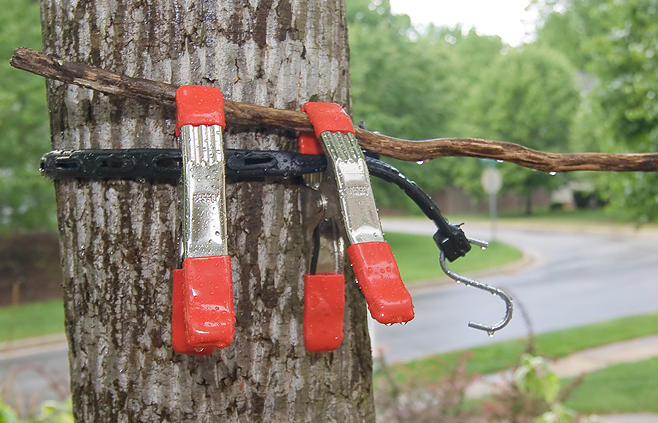
Fig. 9.1.4 :
Being able to temporarily attach branches and adjust their
heights is important for avoiding monotony in your yardbird shots.
This rig consists of a bungee-like strap and two simple clamps bought
from Lowes.
The figure above shows my clamp setup in more
detail. I use a simple rubber bungee-like strap to affix two
clamps to the tree, and then use the clamps to hold the branch.
(Both parts came from Lowe’s home improvement store). I can slide
the whole structure up and down to change the branch height.
The pine siskin below was photographed on an “artificial” perch—artificial in the sense
that it was purchased at (I kid you not) WalMart and then mounted near
a feeder in my front yard; the perch itself is a real tree branch
(corkscrew willow, I believe), though I’m not sure the bird would care
even if it had been entirely of synthetic manufacture.
Fig. 9.1.5 :
Pine siskin (Carduelis pinus), perching on a branch I bought at WalMart.
The branch was actually a very pale color when I bought it; a few weeks
out in the
humid Carolina air resulted in a build-up of mold and mildew,
obliterating the store-
bought look entirely.
You may be surprised to find that chain stores such
as WalMart and others sell a variety of natural tree branches that you
can use to spruce up your yardbird photography . Bamboo, reeds,
and other decorative accoutrements of use in setting up your home
studio can be found in the “home furnishings” department of various commercial
chain stores, typically at very reasonable prices. The items in
the figure below were purchased at WalMart
and World Market stores near
my home; Michael’s art stores
in the U.S. offer a truly more impressive collection of faux branches,
plants, mosses, and other prospective props.
Fig. 9.1.6 : An
array of artificial perches can be bought at your local department
stores such as WalMart, Michael’s, and similar
stores. These are real branches,
not plastic imitations. Each bundle cost about $10 (US).
You can tie them to
trees with twine, or to the pole supporting your bird feeders.
When the birds
come in to the feeder, they’re likely to first perch on a nearby
branch, giving
you a chance to catch a shot of the bird on a novel substrate such as
one of these.
Other items of
use that I’ve found at local chain stores like WalMart include dried
wreaths, garlands, dried decorative bouquets, and in their fabric
department you can get large cuts of fabric of various colors to use as
(out of focus) backgrounds (see section 9.3).
One of the dried
wreaths is shown below; I like to unravel these and hang them from the
trees in my yard like old vines, which birds will very often perch on.
Fig. 9.1.7 : A
leafless wreath that I bought at WalMart. These are
made from real vines (i.e., they’re not plastic). I like to
unwind them
and wrap them around trees and branches in my yard, creating more
perching sites for small birds, as well as adding some natural-looking
detail to scenes. It’s a fast and cheap way to make your yard “viney”.
A number of more exotic items could be of some use
as well. Items such as driftwood, cholla wood, grapewood, and birch branches could
be just the thing to turn your humdrum sparrow shots into more
memorable works of art. Two online retailers that I’ve found
which have a nice variety of products for sale are Blooms & Branches
and Nettleton Hollow;
their prices aren’t the cheapest, and I’ve no idea about the quality of
their products, but it’s worth browsing around their web sites to get
some ideas for useful types of props. Certain items, such as
driftwood, might be easier for you to obtain by just taking a trip to
the local lake or seashore, depending on where you live.
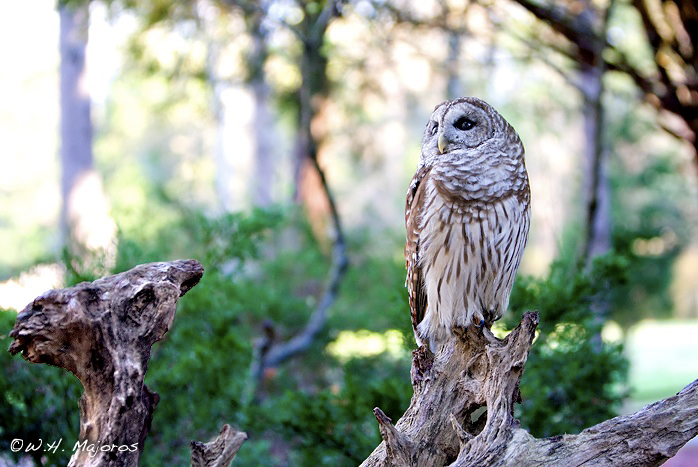
Fig. 9.1.8 :
Driftwood and other sorts of exotic wood substrates can significantly
enhance your opportunities for making interesting bird photos in your
own back
yard. This photo was actually taken at a local raptor
rehabilitation facility during
their bi-annual fund-raising photo op, but many of their props would
look great in
my own yard—whether to support a barred owl or (more likely) a sparrow
or wren.
Although
perches that are entirely natural in appearance are generally to be
preferred for most applications, some items bearing the mark of human
workmanship can still sometimes be useful. The bamboo
vine-support shown below (which I purchased at the local Home Depot) is an ideal example in
that it requires no external support, is the right diameter for many
birds’ feet, and is rustic enough to satisfy many (human)
viewers. It was also cheap, easy to transport in my compact car,
and trivial to install.
Fig. 9.1.9 :
These simple vine trellises, made of some type of
slender bamboo, are trivial to install, and make for good
perches. They’re also cheap and can be found in large
home-improvement chains such as Lowes or Home Depot.
Similarly, the decorative wood strip shown below
supporting this lovely hermit thrush (Catharus
guttatus) obviously bears the mark of human crafting, but is
nevertheless reasonably rustic in appearance (and in this case matches
the overall color composition of the image). When evaluating
items like this that you’re considering placing in your garden or at
your feeder station, keep in mind that after a few weeks outside
they’ll likely lose much of their “store bought” appearance through the natural
weathering process. Many of my props look radically different
today than when I first bought them, due to the accumulation of grime,
fungus, moss—and of course bird droppings.
Fig. 9.1.10 :
Hermit thrush posing on a decorative wooden strip
at the local botanical gardens. These bamboo-like loops are
commonly used to delineate the edges of plots; ground-feeding
birds will often perch on them when scanning for predators.
They’re
certainly rustic enough to look fine in any bird photo. I
generally don’t
think twice about any prop composed primarily of weathered wood.
In terms of
rustic, man-made substrates, wooden feeders and bird houses are an
entire category unto themselves, since they serve multiple
purposes. Don’t forget that bird houses, while possibly used (or
not) by cavity-nesting birds in spring, may also be used by any number
of species for roosting in winter. At any time of year you may
get a chance to shoot birds perched on these various types of
structures, and as long as they’re reasonably rustic in appearance
(i.e., not painted, or made of plastic) they should in many cases be
acceptable when appearing as the main substrate supporting the avian
subject.
Fig. 9.1.11 :
Grackle perched on a wooden bird feeder. Anything
made of weathered wood, even if obviously worked and shaped into
a rectilinear form, can potentially serve as an acceptable substrate
for photos of perching birds. My basic philosophy is that any non-
plastic weathered object is likely rustic enough in appearance to
avoid being gaudy or overly modern or anthropogenic.
Over the longer
term, the planting of decorative trees and vines can be an extremely
effective way to improve the photogenicity of your yard. For the
siskin image below, the bird was perched on a vine that I had purchased
in my local grocery store and placed outside next to my birdbath.
Over the summer the vine grew quite a bit, though I never got around to
removing the pot and planting the bolus into the ground. The
photo below was taken the following winter. As you can see, the
vine provides a fair amount of detail and even color to the image,
giving the eye something to consider after it has finished taking in
all the details of the bird. Don’t underestimate the value of the
substrate in enhancing the overall aesthetics of your photos.
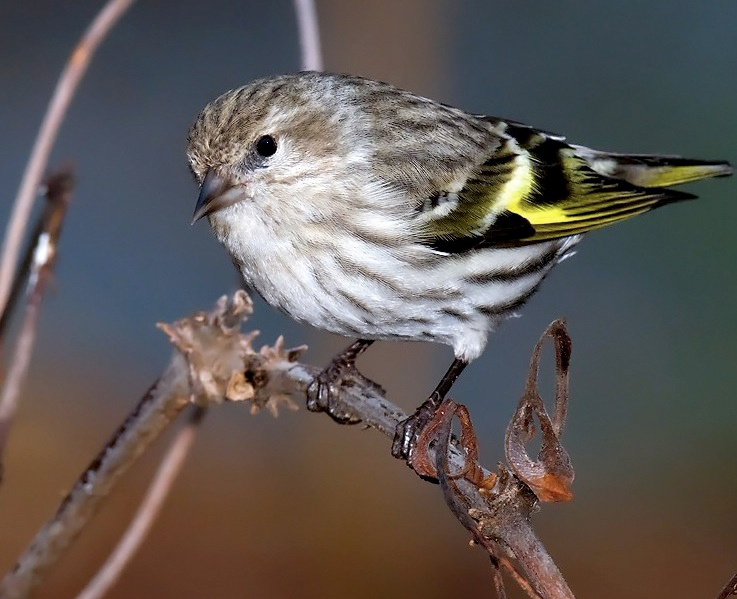
Fig. 9.1.12 :
Pine siskin on a vine. This vine grew from a potted plant that I
placed in my yard and was too lazy to actually de-pot and plant.
Nevertheless,
it provided perching substrates for a number of photos over the
following winter,
when my locale experienced a pine siskin invasion. I’m pretty
sure
the siskins didn’t
mind that I hadn’t properly planted the vegetation.
Several other props that can be
useful—though admittedly more difficult to obtain and install—are tree stumps and boulders. I was lucky enough
to have one of each in my yard, and I’ve tried hard to make copious use
of both. The tree stump I particularly like, because I can
sprinkle bird seed into its crevasses, which keeps the birds coming
back to seek out every last hidden morsel. When I replace the
suet in my suet feeders I’ll sometimes take the leftover portions and
wedge them tightly into a crevasse of the stump as well (being careful
to make sure it’s not too easy for the squirrels to dig out and carry
away). A stump is also a good substrate for draping epiphytes
such as moss (see section 9.2); with a sufficient variety of
draping materials you can make one
stump look like multiple, distinct places in your resulting photo
collection.

Fig. 9.1.13 :
Pine warbler on a stump in my yard. Tree stumps can be enormously
productive props for yardbird photography. I like to sprinkle
some bird seed into
the crevices in the stump in my yard; this induces some birds to spend
more time
on the stump prying out the morsels that have become wedged in
there. Natural
stumps tend to become quite weathered and natural-looking.
Unfortunately, I
don’t think WalMart sells them—yet.
Boulders (i.e., large rocks) are
also very useful—even if they’re a bit difficult to find and
install. Boulders can serve several purposes. First,
because they elevate the bird some distance above the ground, eye-level
shots of birds perched on them tend to have more-or-less blurred
backgrounds, because any nearby vegetation will tend to be offset some
distance behind the subject. In many cases they’ll also have a
very natural, unpolished surface that gives the impression of a totally
wild scene. Finally, spreading some bird seed out on a boulder
can be an effective way to attract ground-feeding birds, since the seed
will generally be highly visible from the air, and because birds may
find foraging on these substrates less risky (since it affords them a
better view of the surrounding area where predators may lurk).

Fig. 9.1.14 :
Slate-colored junco (Junco hyemalis) on a boulder in my yard.
Boulders are useful because you can spread seed on them to lure the
birds,
and many boulders have a rough, natural-looking surface that results in
authentic-
looking photos (i.e., photos that look like they were taken in the
wilderness).
Remember that perches are very important to birds,
and will figure very prominently in photos of perching birds taken in
your yard. Even if you don’t decide to invest in a collection of
exotic branches such as cholla
wood and other notable varieties, putting some effort into having a
variety of perching substrates on your property can help to decrease
the monotony that would otherwise be almost unavoidable after shooting
on a small property over an extended period of time.
Fig. 9.1.15 :
Great-crested flycatcher on a natural perch. The more yardbird
photos you take,
the more you’ll appreciate the value of novel perches—even if they
aren’t overy exotic in an
absolute sense. If you do a significant amount of your bird
photography in your own yard,
then you’ll want to always keep an eye out for novel perches that you
can install, and novel
places in your yard to install them, to help create more variety in
your photos.
Keep in mind
also that the framing of your shots will affect how much of the
substrate is visible in each image. This has several important
implications. First, if you tend to shoot tight shots (i.e., with the bird
very large in frame), then not much of the substrate will be visible in
each shot, so several shots of the bird at different positions won’t
look as redundant as the same number of shots at the same
position. Second, if you’re using high enough magnification the
substrate itself will have significant detail apparent in the image,
and this can be good or bad, depending on the aesthetic quality of the
particular substrate.

Fig. 9.1.16 :
Hummingbird stretching its wings in my front yard. Although it
may come as some surprise, hummingbirds do frequently perch for short
periods
to give their wings a rest, and/or to afford some opportunity to keep
watch over
their territory. This particular branch is part of a native tree
in my yard, and is,
quite honestly, visually boring. I’ve removed the leaves from the
branch to
increase visibility of any birds that happen to perch on it; as a
result, more birds
are also drawn to this branch because it affords them a better view of
their
surroundings, which is useful in predator evasion.
Finally, keep in mind that the more suitable perches
you provide—i.e., perches of a comfortable diameter, with minimal
attached foliage (for photographic purposes), and affording an
expansive view of the environs (for predator-avoidance purposes)—the
more photographic opportunities you may reap, as birds spend a
correspondingly greater amount of time lounging about in your yard.
|
